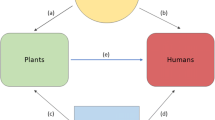Abstract
The terms ‘nutrient’ and ‘limiting factor’ summarise the results of an experiment in which increase in supply results in an increased response. By extension they are often — perhaps usually — used when the user believes that were such an experiment made it would have this characteristic. If the supply is further increased the response diminishes and may, eventually, become negative. ‘Nutrient’ and ‘limiting factor’ therefore apply, strictly, only when the circumstances are specified: they cannot be attached to a particular substance without qualification. The claim that ‘nitrogen is a nutrient (or limiting factor)’ is incomplete. All nutrients are limiting factors, but the reverse is not true. The widespread belief that only one factor can limit a complex process at one time is demonstrably false in general, though it may sometimes be true in particular cases.
Similar content being viewed by others
References
Austin, M. P. & B. O. Austin, 1980. Behaviour of experimental plant communities along a nutrient gradient. J. Ecol. 68: 891–918.
Blackman, F. F., 1905. Optima and limiting factors. Ann. Bot. 19: 281–295.
Blackman, F. F. & A. M. Smith, 1911. On assimilation in submerged water plants and its relation to the concentration of carbon dioxide and other factors. Proceedings of the Royal Society of London B 83: 389–412.
Clymo, R. S., 1984. The limits to peat bog growth. Philosoph. Trans. r. Soc. London B 303: 605–654.
Clymo, R. S., 1997. The ecology of peatlands. Science Progress, Oxford 71: 593–614.
Clymo, R. S., 1991. Peat growth. In Shane, L. C. K. & E. J. Cushing (eds), Quaternary landscapes University of Minnesota Press, Minneapolis: 76–111.
Clymo, R. S., 1992a. Productivity and decomposition of peatland ecosystems. In Bragg, O. M., P. D. Hulme, H. A. P. Ingram & R. A. Robertson (eds), Peatland ecosystems and man: an impact assessment. University of Dundee, Dundee, and International Peat Society, Jyväskylä, Finland: 3–15.
Clymo, R. S., 1992b. Models of peat growth. Suo 43: 127–136.
Evans, G. C., 1972. The quantitative analysis of plant growth. Blackwell Scientific Publications, Oxford, 734 pp.
Golterman, H. L., C. C. Bakels & J. Jakobs-Mögelin, 1969. Availability of mud phosphates for the growth of algae. Verh. int. Ver. Limnol. 17: 467–479.
Harder, R., 1921. Kritische Versuche zu Blackmans Theorie der gergreuzenden Faktoren bei der Kohlensäureassimilation. Jb. Wiss. Bot. 60: 531–542.
Hunt, R., 1982. Plant growth curves. Edward Arnold, London, 248pp.
Maberly, S. C., 1985. Photosynthesis by Fontinalis antipyretica. I. Interaction between photon irradiance, concentration of carbon dioxide and temperature. New Phytol. 100: 127–140.
Nelder, J. A. & R. Mead, 1965. A simplex method for function minimization. Comput. J. 3: 308–313.
Pigott, C. D. & K. Taylor, 1964. The distribution of some woodland herbs in relation to the supply of nitrogen and phosphorus in the soil. J. Ecol. 52 Supp: 175–185.
Press, W. H., B. P. Flannery, S. A. Teukolsky & W. T. Vetterling, 1986. Numerical recipes. The art of scientific computing. Cambridge University Press, Cambridge, 818 pp. [Different versions of this book are published for the computing languages FORTRAN, PASCAL and C.]
Smith, E. L., 1936. Photosynthesis in relation to light and carbon dioxide. Proceeding of the National Academy of Sciences of Washington 22: 504–511.
Talling, J. F., 1957. Photosynthetic characteristics of some freshwater plankton diatoms in relation to underwater radiation. New Phyt. 56: 29–50.
Author information
Authors and Affiliations
Rights and permissions
About this article
Cite this article
Clymo, R.S. Nutrients and limiting factors. Hydrobiologia 315, 15–24 (1995). https://doi.org/10.1007/BF00028627
Issue Date:
DOI: https://doi.org/10.1007/BF00028627




